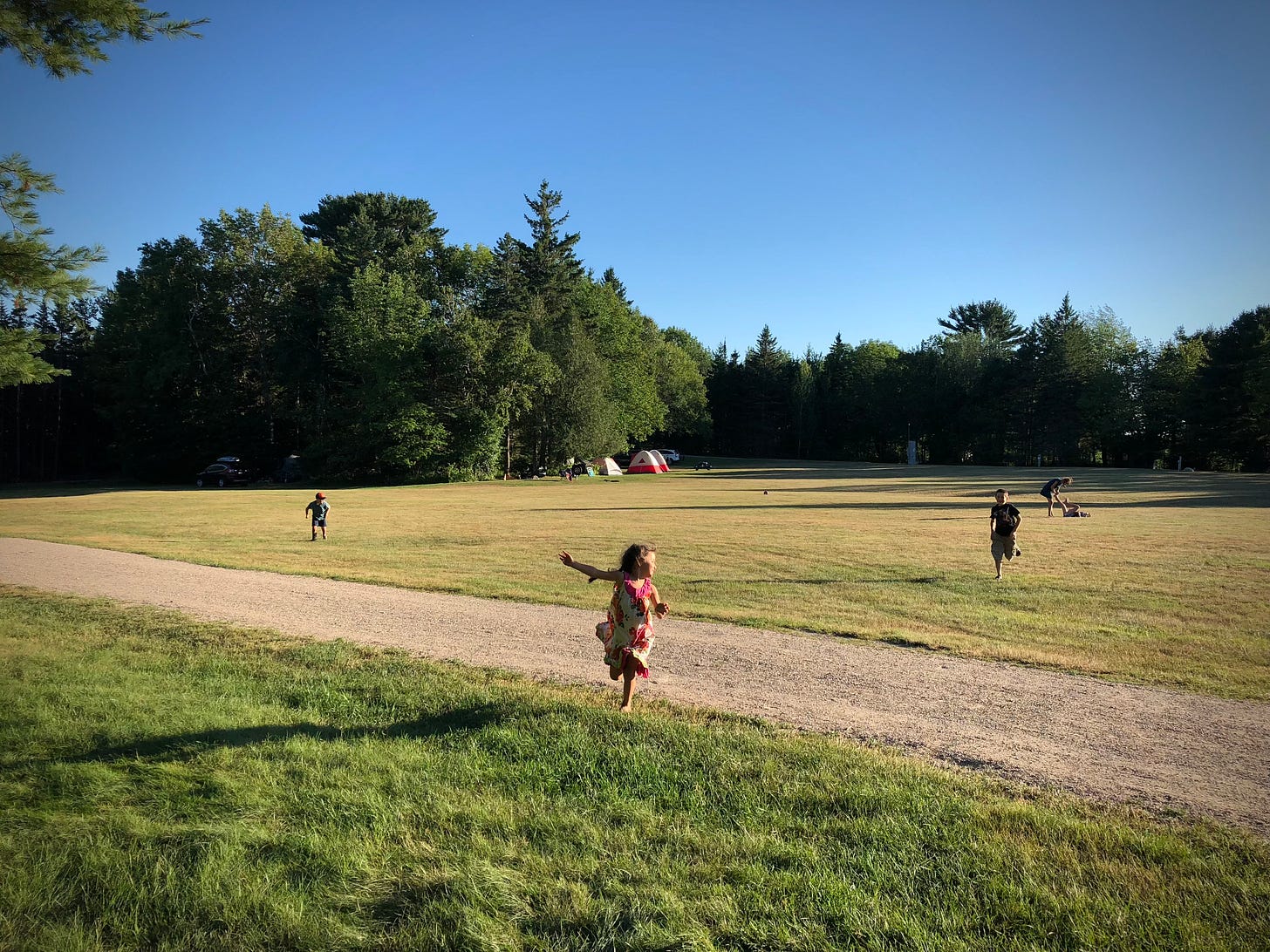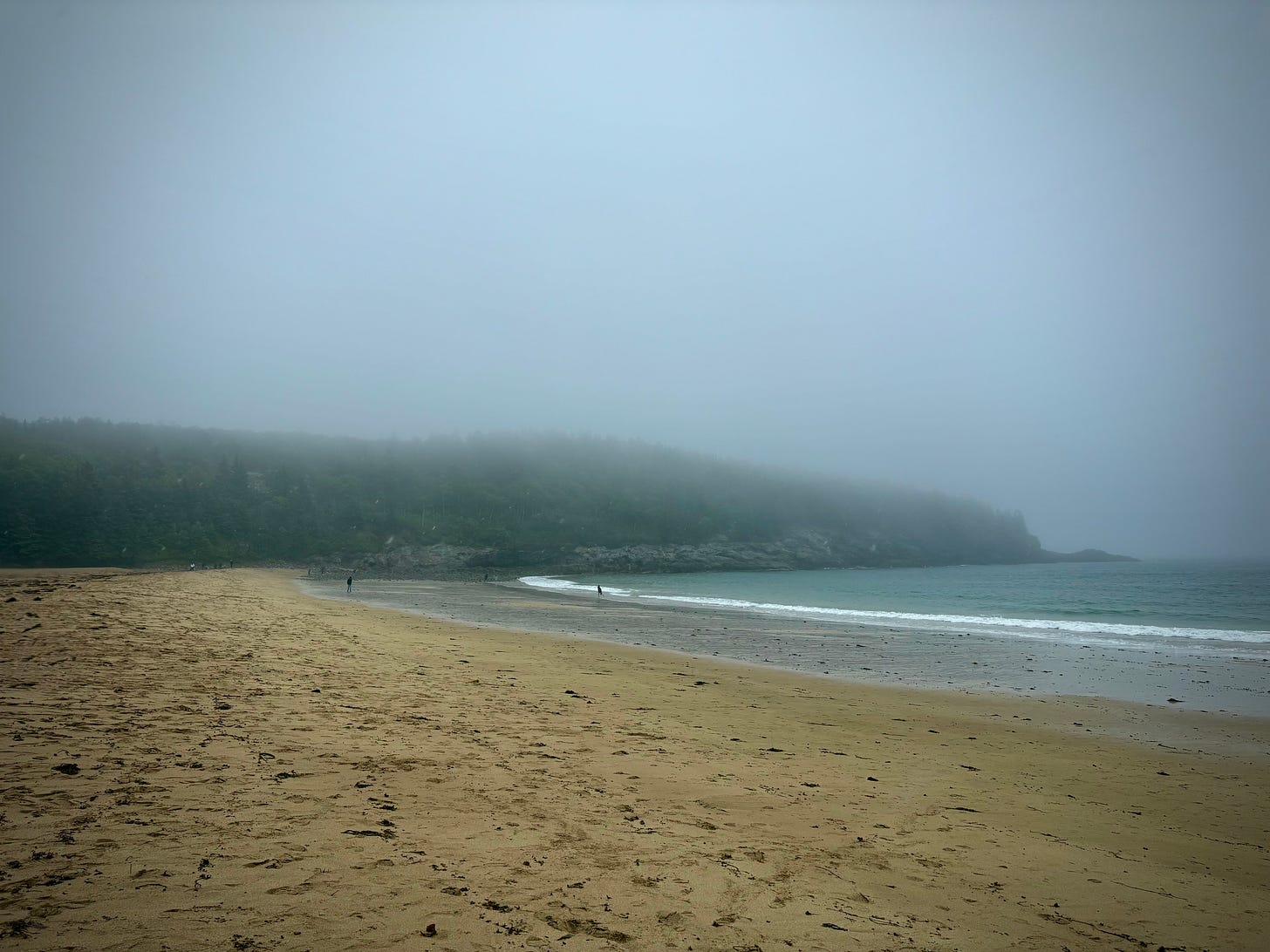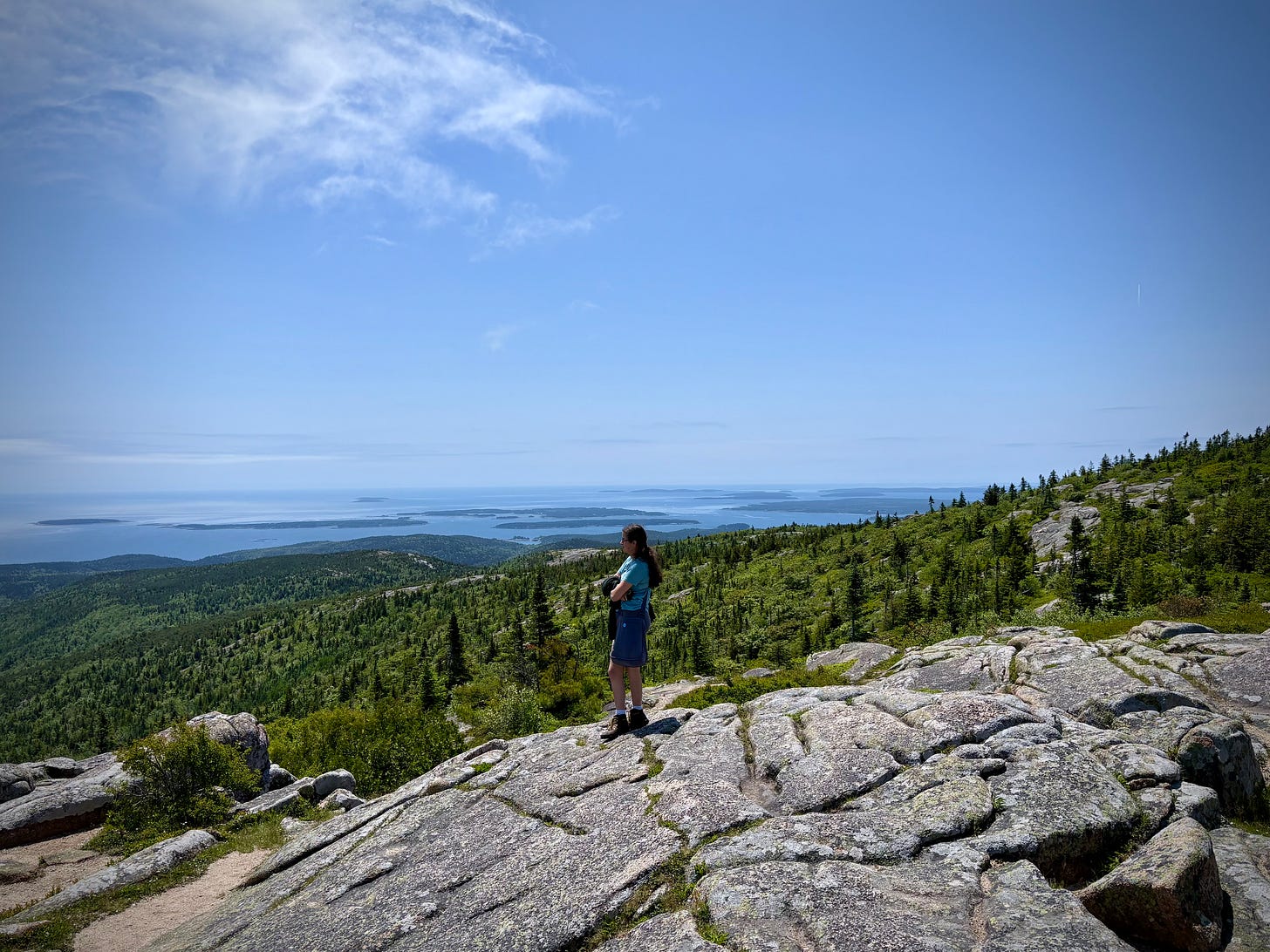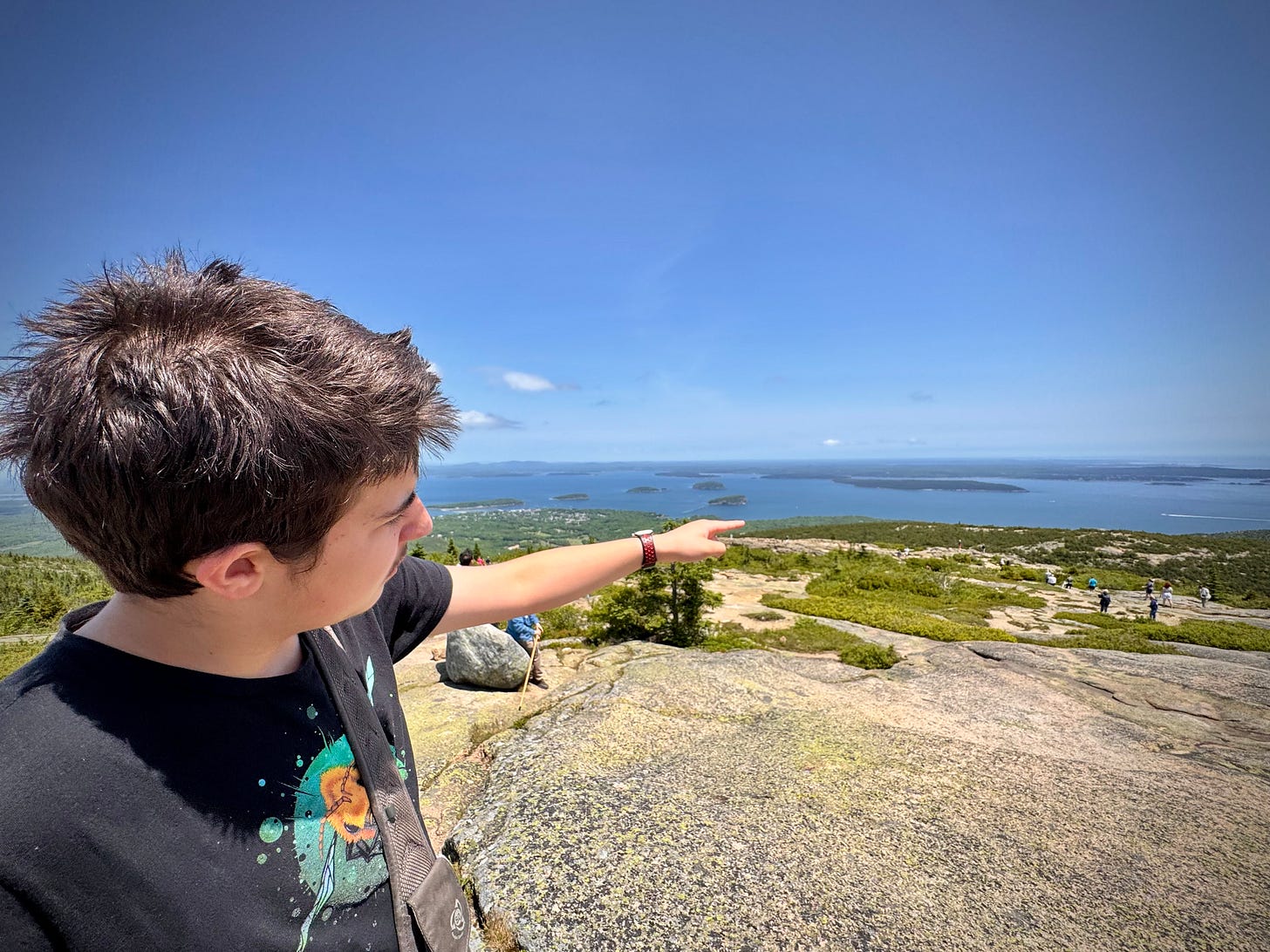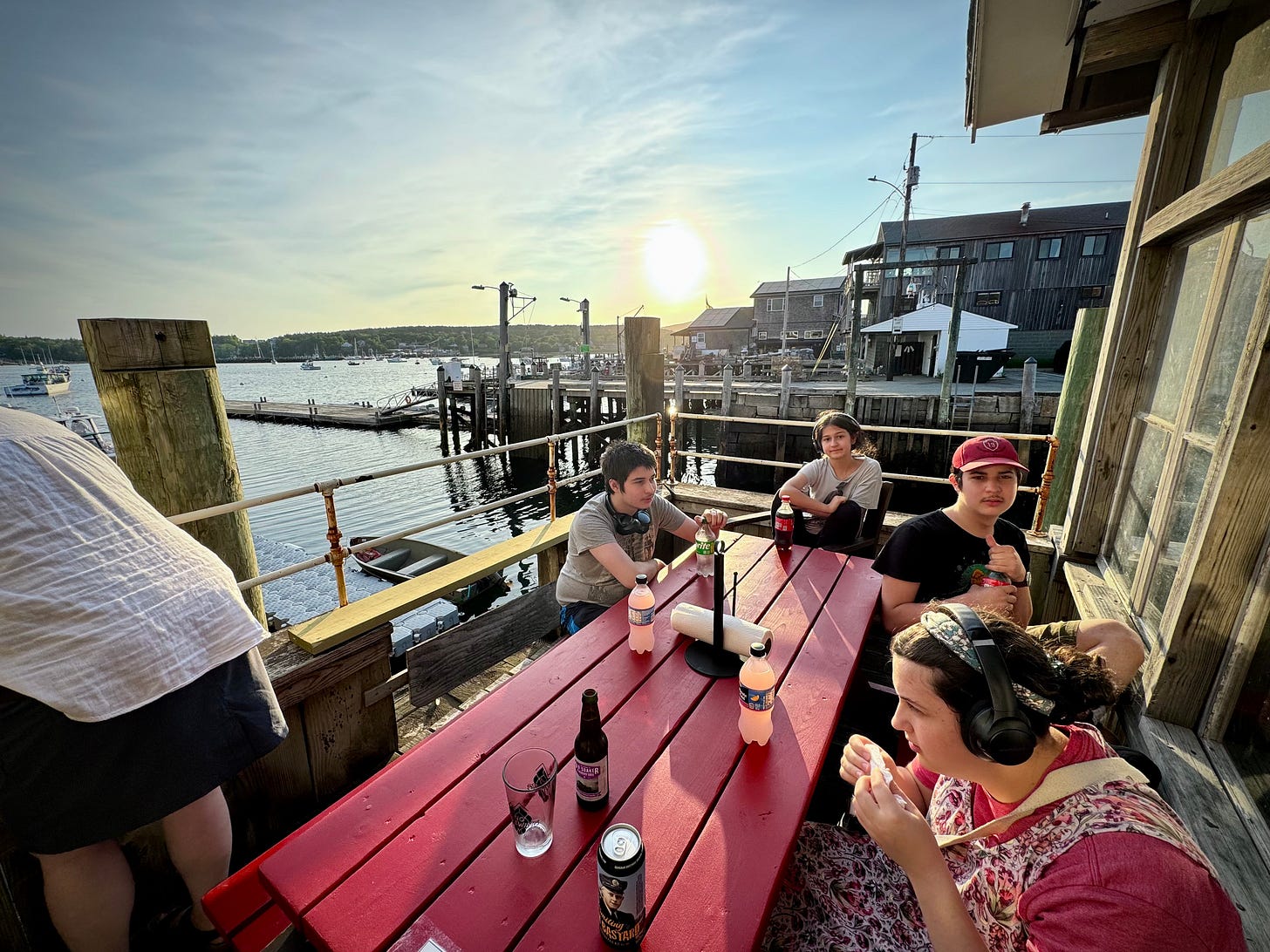How to Visit Acadia Without Losing Your Mind (or Your Wallet)
A family-tested guide to navigating crowds, camping smart, and finding peace in one of America’s most beautiful national parks.
Acadia National Park, located on Maine’s rugged Atlantic coast, is a stunning natural preserve that showcases the best of New England’s wilderness. Encompassing granite peaks like Cadillac Mountain—the tallest on the U.S. Atlantic seaboard—as well as dense forests, rocky shorelines, and glacially carved lakes, the park offers a breathtaking blend of mountain and ocean scenery. Visitors can enjoy more than 120 miles of hiking trails, scenic drives like the Park Loop Road, and historic carriage roads perfect for biking and horseback riding. Acadia is a haven for outdoor enthusiasts, nature lovers, and anyone seeking the serene beauty of coastal Maine.
About 130 million people—roughly a quarter the U.S. and Canadian populations—live within a day’s drive of Acadia, and thus it is an incredibly popular park. In 2023, about 3.88 million people visited the park, making it the seventh-most visited US national park that year. Given its small size compared to the other six parks in the top seven (they are all between 4 times and 65 times larger), you can imagine how crowded Acadia can feel in peak seasons.
I’ve been visiting Acadia for more than 35 years, first with my mom and siblings, then friends, and more recently with my wife and children, and so I think I’ve acquired a good base of knowledge about the park and how to visit it effectively.
In this article, I’m going to reveal my top strategies for getting the most out of a visit to Acadia from the perspective of a large family. We’re not back-country hikers or black diamond mountain trail climbers. We’re just a regular family looking to enjoy the outdoors and relax during a family vacation to one of the most beautiful places in the world.
Where to Stay (Without Going Broke)
The most cost-effective way to visit Acadia is by camping. There are plenty of motels and inns and short-term rentals locally, but they tend to fill up quickly in the summer. There are quite a number of campgrounds on Mount Desert Island itself. Some are nearly vacation resorts in themselves with amenities like water parks. But for our purposes, we tend to favor smaller, quieter campgrounds, especially since our goal is to spend time in the park, not at the campground.
We do not own an RV, but instead stick to tent camping out of our van. As a family of seven, this can pose some challenges, especially since a lot of places have limits on the number of people that can stay on one site.
Another consideration is proximity to park entrances and Bar Harbor and all the major attractions. Fortunately, Mount Desert Island is relatively compact and even from the farthest reaches of the island, it doesn’t take more than 30 or 40 minutes to get to, say, one of the Park Loop Road entrances.
That’s why we tend to stay on what’s called “the Quiet Side” of the island. (Mount Desert has two lobes, split by a sound. The western, or left, lobe is known as the Quiet Side; the eastern side includes Bar Harbor and most of the park.) Our preferred campground is Smuggler’s Den. This small campground is reasonably priced and never full. They have several bathhouses, including a brand new, gorgeous one by the tent sites. There’s free wifi, a small shop, and conveniently placed water and trash receptacles. It’s kept clean and they ensure that it’s a peaceful and quiet place to stay. The tent sites nestled in the woods around the big field are especially quiet. Since it is comparatively far from the park entrance, it’s a nice respite. Plus there’s a convenient grocery store just a quarter mile down the street from the entrance and it’s very close to Echo Lake, which has a swimming beach.
Another cost-effective camping option is the park-managed campgrounds Blackwoods and Seawall. (There are also two other park campgrounds on parts of the park off Mount Desert Island on Schoodic Peninsula and Isle au Haut.) Both Blackwoods and Seawall are accessed from outside roads so you can get in and out even when the Loop Road is closed at night. Each offers flush toilets, picnic tables, fire rings, and paved roads—but no hot water or electricity. These campgrounds do fill up quickly. The best part is their remoteness inside the park. I stayed once at Blackwoods and you can walk down a trail that takes you to the Loop Road and the water’s edge. At night, there are no artificial lights in the sky because you’re in the middle of the park, and all you can see on a clear night is the swell of the ocean and stars from horizon to horizon.
Getting Around the Park
We’ve found that if you plan your days right, you can see most everything worthwhile in just a few days, leaving you plenty of time to hang out and relax. As I said, we’re not big backwoods or mountain trail hikers, but if you are, try to find the trails that aren’t on the Park Loop Road to avoid the big traffic jams in parking lots. Everyone wants to go to the Precipice trail or hike up Cadillac Mountain, but there are lots of trails in the park that won’t feel like rush hour in the city as the popular trails often do.
If you’re looking for a more relaxed pace, Acadia’s carriage roads offer a unique experience. Bring or rent bikes and you can travel along 45 miles of these old well-maintained rustic roads that meander through the hills and forests. You can also hike them or rent horses or horse-drawn carriages. The vast majority of visitors to the park don’t go beyond the Park Loop Road or major sites accessible by car, so this is your best bet for easy access to serene natural experiences.
Even if you just want to stick to the Loop Road, you can still avoid the worst crowds and have fun. First, make sure to get your park pass in advance. You can buy it online and then put the pass in your smartphone wallet (Apple Wallet or Google Wallet). The basic pass is good for a week.
What to Skip (Trust Me)
What should you see on the Park Loop Road? My recommendation is to avoid Sand Beach. Yes, it is the only Sand Beach in the park. Yes, you are visiting the ocean. However, this is coastal Maine and the water will be cold, if not frigid. If you wanted to go sunbathing on a beach, you would have gone to Florida or the Outer Banks or Cape Cod. The problem is that everybody goes to Sand Beach when the sun is out. The parking lot fills up immediately, leaving people to park along the loop road and then it’s a long, long walk to the beach. Trust me, it’s not worth it. If you get any inclement days during your trip, go then and see the beauty of the beach, but it’s not a must-see.
This next tip may also be controversial advice, but I’m going to give it: Don’t go to Thunder Hole. If you’re not aware, Thunder Hole is a natural formation in the rocky coast, which when the tide and waves are right, cause a loud thundering sound as the waves crash in. This popular spot has walkways and steps and railings to make it easy to get right next to Thunder Hole. Maybe too easy. Thunder Hole is always crowded and once again, parking is at a premium. Plus, all the viewing spots along the railing get crowded and it’s hard to see. And the upshot is that on a beautiful summer day, there’s not much happening. The best time to see Thunder Hole is when it’s rainy and/or windy and the waves are crashing, because then it lives up to the name and then nobody else will be there.
“We’re just a regular family looking to enjoy the outdoors and relax during a family vacation to one of the most beautiful places in the world.”
On particularly stormy days, the National Park Service may close the lower walkways because the waves crash over them and it becomes very wet and dangerous—but from above you can still see and hear plenty and it will be a lot drier. However, when it’s stormy and windy enough to cause some wave action, but not so stormy as to close things down, that’s ideal.
And that’s one of the best bits about Acadia: Even when the weather is “bad”, there’s plenty to see and do. Even in the midst of summer, coastal Maine is still relatively mild. Yes, there are hot, humid days, but there’s always cool ocean breezes. And yes, there are rainy days to cool things off. Nighttime sleeping is always comfortable in Acadia.
Instead of Thunder Hole, continue driving on the Loop Road until you find a section where there’s not a lot of people, where you can park on the side of the road (parking and no parking areas are marked), and where you have easy access onto the boulder strewn water’s edge areas. Much of the coastline is piles of massive granite boulders strewn around by the forces of weather and erosion over the course of millions of years. Kids, especially, love to clamber about, looking in dark crevices and poking into tide pools. For myself, I love to just sit and listen to the waves and hear the gulls and relax. Just keep an eye on the kids and yourself—wet rocks are slippery and may shift underfoot. We often spend an hour or more in one of these spots, climbing around or just sitting.
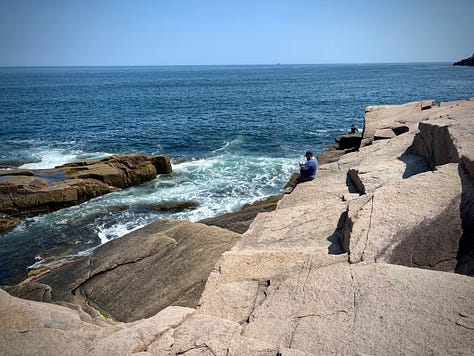
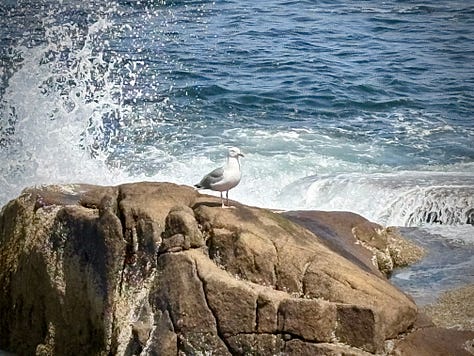
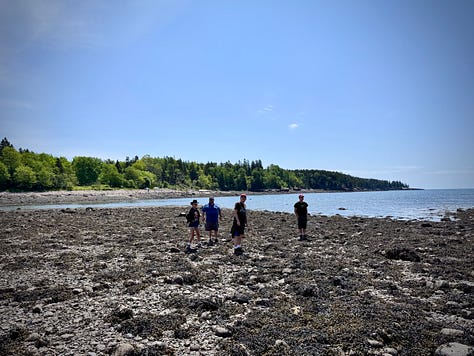
Another quiet spot, if you’re still craving a beach experience of a sort, is Otter Cove. This quiet spot also requires you to park along the road, but then it’s a nice walk right onto a gravel beach. At low tide, there are many more tide pools, but at any time, it’s a pleasant place to sit. If you’re brave or especially warm, you can even dip your feet in the water here. I recommend water shoes to protect your feet from the gravel, if you do that.
Another popular spot that is always packed is Jordan Pond. There’s a restaurant and shop here and their famous popovers and tea on the lawn overlooking the pond and the far hills known as the Bubbles. It’s a gorgeous spot, but the wait for a table is often long. Don’t bother with the main parking lot as it’s always full and head over to the secondary lot. If there’s a space, hike back to the main site along the pond-side trail. Lay out your own blanket and a picnic lunch, save yourself some time and money, and enjoy the view. If you can’t find a parking space, try again on a rainy day or skip it. While the pond is pretty, it’s far from a must see as it is just one among many beautiful places to see.
Cadillac Mountain and Other Must-Sees
One place you really must see, though, is the summit of Cadillac Mountain. Cadillac is the highest Atlantic coastal peak in the U.S. and for part of the year is the first place in the US to see the sunrise (early October to early March). If you’re an early riser you can go and see the sunrise from the top of the mountain, but even if you visit at a more civilized hour, the views are spectacular. You can drive to the summit, but you’ll need a reservation with a 30-minute window. This system, recently introduced, has made parking much easier. Like the other popular spots, the parking lots fill fast and it was frustrating to spend forever waiting for someone to leave so you could park. Now, parking is much easier. There’s plenty of open space on the mountain to climb around. Later in the summer, you can even find wild blueberries growing in the crags. This is dramatic scenery and while it’s always crowded–even with the new reservation system–it’s always possible to find a quiet place to sit.
The gift shop at the top of the mountain is nice place to visit. In addition to the welcome bathrooms, you can buy a coffee mug or t-shirt or, my favorite, blueberry soda.
Meal times can be challenging for families on a budget. We always pack a cooler full of sandwich fixings and then picnic. A particularly nice location is the Fabbri picnic area, just before Otter Cove, with bathrooms, and several picnic tables tucked into a lightly wooded area. Bear Brook picnic area is at the other end of the Loop Road, also in a wooded area.
We prefer to cook most meals in our camp site, although our first night we always stop by Beal’s Lobster Pier in Southwest Harbor. It’s close by Smuggler’s Den and the harbor side dining is incredible. It isn’t cheap, but hey it’s vacation.
“Even when the weather is ‘bad’, there’s plenty to see and do.”
Visiting Bar Harbor
What about Bar Harbor itself? You’ll want to visit at some point. Parking is always crowded. All street and public lot parking is paid via an app. There’s lots of restaurants, often very busy, and well, eating out anywhere these days is expensive. There’s no fast food options. You’ll find souvenir shops, a charming bookstore, and just about everything you’d expect from a bustling tourist town.
Final Thoughts (and Your Turn)
It is possible to visit Acadia with your family without breaking the bank or spending all your time in traffic or big crowds with a little advance planning. I hope my article has been helpful in that regard.
If you’ve got your own tips or questions about Acadia, I’d love to hear them in the comments



